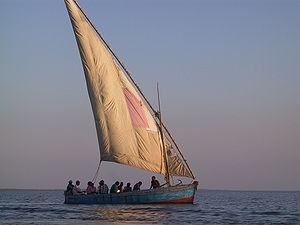Inhambane Province
Inhambane is a province of Mozambique located on the southern coast of the country. It has an area of 68,775 km² and an approximate population of 1,271,818 in 2007. The provincial capital is also called Inhambane.
History
The city of Inhambane existed as early as the 10th century, and was the southernmost port used by the Arabs in their slave trade. Vasco da Gama reached it in 1498, who claimed the Bay of Inhambane for Portugal. The Portuguese settled in 1534.
Economy
Inhambane is, after Nampula, the second province in cashew production. Citrus and coconuts are also produced, highlighting the coconut soap factory. In addition there is an intense fishing activity.
Political division
Inhambane province is administratively divided into twelve districts and two cities:
- 01 City of Inhambane
- 02 Funhalouro,
- Future, headquarters.
- I took,
- 03 Govuro:
- New Mambone, headquarters.
- Save.
- 04 Homoíne:
- Homoíne, headquarters.
- Pembe.
- 05 Inharrime:
- Inharrime, headquarters.
- Mocumbi.
- 06 Inhassoro.
- Inhassoro, headquarters.
- Bazaruto.
- 07 Jangamo:
- Jangamo, headquarters.
- Cumbana.
- 08 Mabote:
- Mabote, headquarters.
- Zimane.
- Zinave.
- 09 Massinga:
- Massinga, headquarters.
- Chicomo.
- 10 Maxixe City
- 11 Morrumbene:
- Morrumbene, headquarters.
- Mucodoene.
- 12 Panda:
- Panda, headquarters.
- Mawayela.
- Urrene.
- 13 Vilanculos:
- Vilankulo, headquarters.
- Mapiñane.
- 14 Zavala:
- Quissico, headquarters.
- Zandamela.
Environment
The climate is tropical, more humid on the coast, which is occupied by mangroves. Within its ecoregions are the Inhambane coastal mosaic rainforest, Zambezi brackish, southern miombo bushveld, and eastern African mangrove fragments.
Tourism
Inhambane Bay is of tourist importance as well as being home to the last remaining dugongs in Mozambique.
- Bazaruto National Park.
- Inhambane City Market.
- Beaches of Ponta da Barra and Tofo (21 km from the city).
- Vilanculos.
Contenido relacionado
Etruscans
Cantabrian lábaro
Garcia I of Leon



